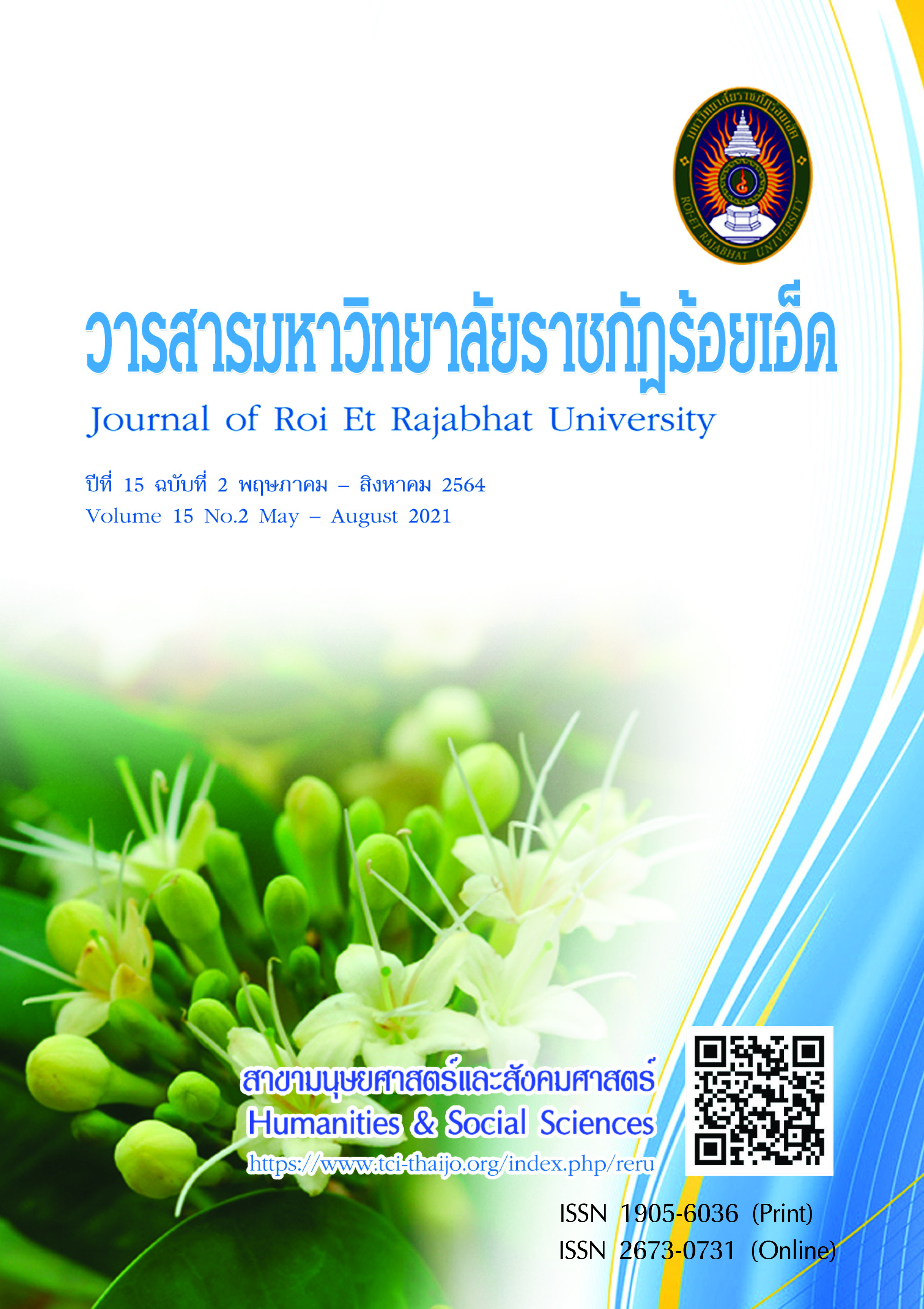Innovative Leadership of School’s Administrators Affecting Innovative Organization of Schools under the Office of Roi Et Primary Educational Service Area 3
Keywords:
Leadership, Innovative leadership, Innovative organizationAbstract
The purposes of this research were to: 1) study innovative leadership of school’s administrators; 2) study innovative organization of schools, and 3) create the prediction equations of innovative leadership of school’s administrators affecting innovative organization of schools under the office of Roi Et primary educational service area 3. The samples were 323 administrators and teachers in schools under the office of Roi Et primary educational service area 3 in 2018 academic year. The research instrument used for data collection was a five rating scales questionnaire with reliabilities of Cronbach’s alpha coefficient were 0.901 and 0.820. The statistical techniques employed in data analysis were percentage, mean, standard deviation and Pearson Product Moment Correlation Coefficient. Regression equations were created for predicting dependent variables through Stepwise Multiple Regression analysis. The research findings were as follows: 1. The level of innovative leadership of school’s administrators of schools in the office of Roi Et primary educational service area 3 in overall and individual aspect were at a high level. 2. The level of innovative organization of schools in the office of Roi Et primary educational service area 3 in overall and individual aspect were at a high level. 3. Innovative leadership of school’s administrators affecting innovative organization of schools under the office of Roi Et primary educational service area 3, there were 5 aspects: vision (X1), risk management (X5), team working (X3), flexibility (X4) and creativity (X2). It could predict 85.10%. The prediction equations could be written as follow: The regressive equation in the form of raw score (Unstandardized Score) Y´ = .240 + .237X1 + .192X5 + .176X3 + .175X4 + .164X2 The regressive equation in the form of standard score (Standardized Score) Z´y = .247ZX1 + .199ZX5 + .218ZX3 + .194ZX4 + .172ZX2
References
กีรติ ยศยิ่งยง. (2552). องค์กรแห่งนวัตกรรม แนวคิดและกระบวนการ. กรุงเทพฯ: จุฬาลงกรณ์มหาวิทยาลัย.
ขวัญชนก โตนาค. (2556). การวิเคราะห์องค์ประกอบภาวะผู้นำเชิงนวัตกรรมสำหรับผู้บริหารสถานศึกษาขั้นพื้นฐาน.
วารสาร ศึกษาศาสตร์ มหาวิทยาลัยนเรศวร, 16(4), 134-135.
ชวน ภารังกูล. (2556). การศึกษาความเป็นองค์กรแห่งนวัตกรรมของสถานศึกษาขั้นพื้นฐาน สังกัดคณะกรรมการการศึกษา
ขั้นพื้นฐานในจังหวัดราชบุรี. ราชบุรี: มหาวิทยาลัยราชภัฏหมู่บ้านจอมบึง.
ณัฐ ธาระสืบ, นิภา รุ่งเรืองวุฒิไกร, กฤติยา นงวณิชย์ และชัยฤทธิ์ ทองรอด. (2562). ความสัมพันธ์ของภาวะผู้นำเชิงนวัตกรรม
ประสิทธิผลของผู้นำและความสามารถในการแข่งขันของวิสาหกิจขนาดกลางและขนาดย่อมในกรุงเทพมหานคร.
วารสารดุษฎีบัณฑิตทางสังคมศาสตร์, 9(2), 546-559.
ณัฐวุฒิ ศรีสนิท และโกวัฒน์ เทศบุตร. (2563). ภาวะผู้นำเชิงนวัตกรรมของผู้บริหารสถานศึกษาที่ส่งผลต่อประสิทธิผลของ
สถานศึกษา สังกัดสำานักงานเขตพื้นที่การศึกษาประถมศึกษาร้อยเอ็ด เขต 3. วารสารการบริหารและนิเทศ
การศึกษามหาวิทยาลัยมหาสารคาม, 11(1), 20-30.
น้ำค้าง ไชยพุฒ. (2549). นิยามใหม่ของ “สามารถ”. ผู้จัดการ, 23(272), 94-101.
บุญชม ศรีสะอาด. (2553). การวิจัยเบื้องต้น (พิมพ์ครั้งที่ 8). กรุงเทพฯ: สุวีริยาสาส์น.
ปริวัฒน์ ยืนยิ่ง. (2563). ภาวะผู้นำเชิงนวัตกรรมของผู้บริหารสถานศึกษา วิทยาลัยเทคนิคอุบลราชธานี. วารสารนวัตกรรม
การศึกษาและการวิจัย, 4(3), 330-344.
พสุ เดชะรินทร์. (2546). Balance Scorecard รู้สึกในการปฏิบัติ. กรุงเทพฯ: จุฬาลงกรณ์มหาวิทยาลัย.
โรงเรียนดรุณสิกขาลัย. (2553). โรงเรียนดรุณสิกขาลัย โรงเรียนนวัตกรรมแห่งการเรียนรู้. สืบค้นเมื่อ 10 กรกฎาคม 2561,
จาก http: //e-school.kmutt.ac.th/theory.php
วิทยากร ยาสิงห์ทอง และกนกอร สมปราชญ์. (2562). ภาวะผู้นำเชิงนวัตกรรมที่ส่งผลต่อการเป็นบุคคลแห่งการเรียนรู้ของครู
สังกัดสำนักงานเขตพื้นที่การศึกษามัธยมศึกษาเขต 25. วารสารศึกษาศาสตร์ ฉบับวิจัยบัณฑิตศึกษา
มหาวิทยาลัยขอนแก่น, 11(3), 234-244.
เวียงวิวรรธน์ ทำทูล และวัลลภา อารีรัตน์. (2557). ภาวะผู้นำ เชิงนวัตกรรมของผู้บริหารที่ส่งผลต่อองค์การขีดสมรรถนะสูง
ของโรงเรียนในสังกัดสำนักงานเขตพื้นที่การศึกษามัธยมศึกษา เขต 21. วารสารศึกษาศาสตร์ มหาวิทยาลัยขอนแก่น,
(3), 31-38.
สมจิตร ชูศรีวาส และหทัย น้อยสมบัติ. (2562). ภาวะผู้นำเชิงสร้างสรรค์ของผู้บริหารสถานศึกษาที่ส่งผลต่อประสิทธิผลของ
โรงเรียนสังกัดสำนักงานเขตพื้นที่การศึกษาประถมศึกษากาฬสินธุ์ เขต 1. วารสารมนุษยศาสตร์และสังคมศาสตร์
มหาวิทยาลัยนครพนม, 9(3), 53-61.
สัมฤทธิ์ กางเพ็ง และสรายุทธ กันหลง. (2553). ภาวะผู้นำใฝ่บริการ แนวคิด หลักการ ทฤษฎีและงานวิจัย. ขอนแก่น:
คลังนานาวิทยา.
สุพล ธรณี. (2539). การศึกษาการใช้ฐานแห่งอำนาจของผู้บริหารโรงเรียนมัธยมศึกษา สังกัดกรมสามัญศึกษา จังหวัดร้อยเอ็ด.
มหาสารคาม: มหาวิทยาลัยมหาสารคาม.
สำนักงานคณะกรรมการการศึกษาขั้นพื้นฐาน. (2561). ระบบข้อมูลสาระสนเทศเพื่อการบริหาร. สืบค้นเมื่อ 10 กรกฎาคม 2561,
องค์อร ประจันเขตต์. (2557). องค์กรแห่งนวัตกรรมการศึกษา ทางเลือกใหม่ของการบริหารการศึกษา. วารสารพยาบาลทหารบก,
(1), 45-51.
อรรธิกา พังงา. (2555). เส้นทางสู่การสร้างองค์กรนวัตกรรม. สืบค้นเมื่อ 10 กรกฎาคม 2561,
จาก http: //articles.citu.tu.ac.th/wpcontent/uploads/2013/04/Research10new.pdf.
อรวรางค์ จันทร์เกษม, วรกมล วิเศษศรี และสุภัททา ปิณฑะแพทย์. (2558). ความสัมพันธ์ระหว่างปัจจัยส่วนบุคคล ภาวะผู้นำ
เชิงนวัตกรรมของผู้บริหาร ตามความคิดเห็นของพนักงานและพฤติกรรมมุ่งผลสัมฤทธิ์ในการทำงานของพนักงาน
ในอุตสาหกรรมการผลิต. วารสารวิชาการศิลปศาสตร์ประยุกต์, 8(1), 138-144.
อรอนงค์ โรจน์วัฒนบูลย์. (2553). การพัฒนาตัวแบบผู้นำเชิงนวัตกรรม.วิทยานิพนธ์ รัฐศาสตรดุษฎีบัณฑิต สาขาวิชาการบริหาร
การพัฒนา. กรุงเทพฯ: สถาบันบัณฑิตพัฒนบริหารศาสตร์.
Adair, J.E. (1996). Effective Innovation: How to Stay Ahead of the Competition. London: Pan Books.
Christiansen, J.A. (2000). Building The Innovative Organization: Management Systems that encourage
Innovation. Hampshire: Macmillan Press.
Drucker, P. (2002). Our Definition of Leadership. (Online). Retrieved January 8, 2008,
From http://www.teal.org.uk//Leadership//definition.html
Fulton Schools. (2014). Fulton County Schools Innovation Update: We are ready. Retrieved July 10, 2018,
From http//www.pearsoned.com/education-blog/fulton-county-schools-innovation-update-we-
are-ready/
George Asamoah. (2012). Factors Which Influence the Buying Behaviours of Customers with Multiple
Regular Customer Cards. Degree Thesis (International Business): Arcada.
Higgins, J.M. (1995). Innovate or Evaporate: Test & Improve Your Organization’s IQ-It’s Innovation
Quotient. New York: New Management.
Merx-Chermin, M., and Nijhof, W.J. 2005. Factors influencing knowledge creation and innovation in an
organization. Journal of European Industrial Training, 29(2), 135-147.
Microsoft Educator Network. (2003). Microsoft Innovative Educator Programs. Retrieved July 10,2018,
From https: //education.microsoft.com/GetTrained
Miller, W.J., Sumner, A.T. and Deane, R.H. (2009). Assessment of quality management practices within
the healthcare industry. American Journal of Economics and Business Administration, 1(2), 105-113.
Pollock, S.E. (2001). Organization Behavior (9th ed.). New Jersey: Prentice-Hall.
Quinn, R.E., and Spreitzer, G.M. (1991). The Psychometrics of the Competing Value: Culture Instrument and
an Analysis of the Impact of Organizational Culture on Quality of Life. Research in organizational
change and development, 5(1), 115-142.
Roscorla, T. (2010). The 7 steps to Innovative leadership. Retrieved July 10, 2018,
From http://www.convergemag.com/policy/the-7-Elements-of-lnnovativeLeadership.html
Tidd, J., Bessant, J., and Pavitt, K. (2001). Managing Innovation Integrating Technological Market and
Organization Change. Chichester: John Willey & Sons.
Downloads
Published
How to Cite
Issue
Section
License
บทความที่ได้รับการตีพิมพ์เป็นลิขสิทธิ์ของวารสารมหาวิทยาลัยราชภัฎร้อยเอ็ด
ข้อความที่ปรากฏในบทความแต่ละเรื่องในวารสารวิชาการเล่มนี้เป็นความคิดเห็นส่วนตัวของผู้เขียนแต่ละท่านไม่เกี่ยวข้องกับมหาวิทยาลัยราชภัฎร้อยเอ็ด และคณาจารย์ท่านอื่นๆในมหาวิทยาลัยฯ แต่อย่างใด ความรับผิดชอบองค์ประกอบทั้งหมดของบทความแต่ละเรื่องเป็นของผู้เขียนแต่ละท่าน หากมีความผิดพลาดใดๆ ผู้เขียนแต่ละท่านจะรับผิดชอบบทความของตนเองแต่ผู้เดียว





